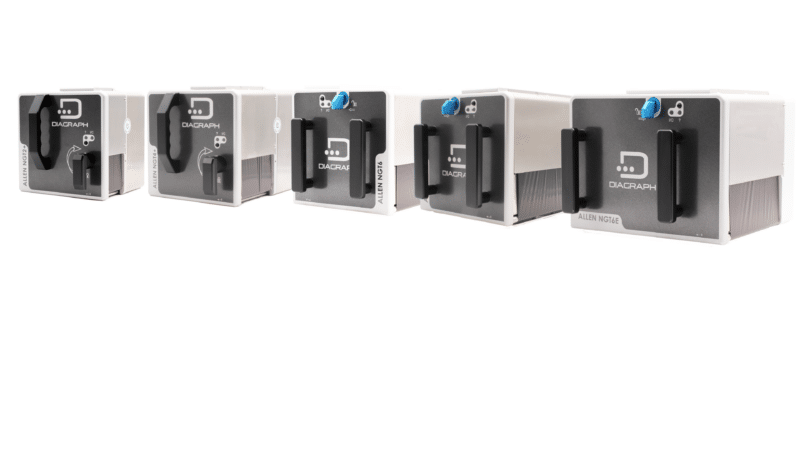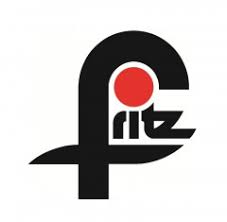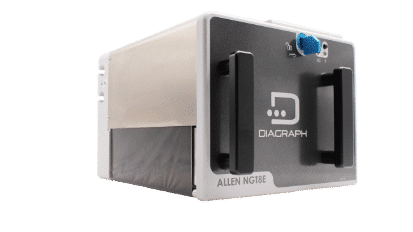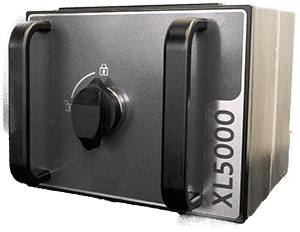Are you looking for a printer for industrial application with high print quality? Then you've come to the right place: Diagraph's thermal transfer printer is considered one of the first reliable printers on the market and has stood the test of time. Produced in Germany, our TTO (Thermal Transfer Overprint) systems convince through durability, top quality and are still easy to operate.
The Allen NGT thermal transfer printer currently has the largest print area on the market, while the Allen XL5000 is ideal for entry-level printers.
Overview of our thermal transfer printers
Reliable, proven systems from Diagraph.
You can order the following thermal transfer printers from us - including thermal transfer ribbon and label software:
Thermal transfer printer Allen NGT
The thermal transfer printer NGT comes from Germany and is produced in this country. High cycle rates, serialization, best print quality and the largest possible print image are the strengths of the series, which is often used for packaging films and labels. The Allen NGT performs the complete spectrum from precise application of the expiration date to complete marking of the packaging in case of changing dates or languages. All data can be loaded via different interfaces. Variable printhead sizes (55 mm to 213 mm) allow a wide range of applications in various commercial fields. Operation via the TouchPro control is particularly practical.
Thermal transfer printer Allen XL5000
The XL5000 thermal transfer printer guarantees entry into digital product labeling. It has the full range of functions. Especially when the labeling changes and production has to be switched flexibly, the Allen XL5000 scores in terms of low downtime. Other advantages are the large ribbon capacity and the attractive price. Using a:touch Lite, an industrial-grade control panel with touch screen, the printing system is controlled directly on your production line. This makes it possible to modify printer settings or change the print image in a timely manner. Of course, the query and display of the current status are always possible.
What are thermal transfer printers?
Thermal transfer printers are printers that use ribbons and heat to transfer ink to the media. This produces a precise and consistent print image. The label printers have proven themselves to this day and are frequently used in industry.
Our Allen XL5000 and Allen NGT series have proven themselves in the market and are used in various industries. Our thermal transfer overprint systems impress with their durability and print results - they offer unparalleled quality on the market.

Technology: How does a thermal transfer printer work?
In thermal transfer printing, printers control the printing process by means of numerous small heating elements in the print head. The targeted heating of these thermocouples melts away selective parts of the ink ribbon, which adhere precisely to the materials and labels to be printed during cooling. This results in a clear, convincing print image with long durability, such as is required in product labeling.
Thermal transfer printer in the industry
Thermal transfer printing is commonly used in industries such as shipping, healthcare, pharmaceuticals, and retail. In industry, for example, the process is used for film, bag and sack marking. The label printers offer the possibility of accommodating numerous pieces of information with pin-sharp definition on very small areas. This information can consist of small texts, but the application of a QR code is of course also possible without any problems. Logos, texts, barcodes and variable data such as expiration date or batch number represent further applications. In addition, thermal transfer printers are suitable for textiles. The following table provides an example of the extensive range of applications for our products and services.
Thermal transfer printer - application examples
| Sector/industry | Examples |
|---|---|
| Logistics | Shipping labels, transport labels |
| Electronics industry | Device labelling, type plates, warning labels |
| Laboratory | Laboratory labels, cold storage labels |
| Quality labelling | Labels for components and devices |
| Food labelling | Indication of ingredients on labels |
Thermal transfer printer prints plastic packaging
Thermal transfer printers are ideally suited for printing on film packaging. In the video shown here you can see how the printing looks exemplary with the model Diagraph Allen NGT4+.
Advantages of thermal transfer printers
Pin sharp on a very small area
In summary, thermal transfer printers using foil ensure fast, high-quality, commercially viable and cost-effective printing.

Disadvantages of thermal transfer printers
Please note that when using thermal transfer printers, usually only single-color printing is possible. According to the coating of the ribbon, it is possible to print in black as well as monochrome. Gray can only be displayed rasterized.
Special attention should be paid to data protection. Unlike other types of printers, such as laser printers, thermal transfer printing with foil generates materials that may contain security or business-related information. Therefore, it is important to make the ribbons unrecognizable after their period of use. Only then are sensitive data and trade secrets properly protected.
Compared to direct thermal printing, the printing speed is a little slower because the ink is first melted from the ribbon by heating. Nevertheless, the speed of a thermal transfer printer can be classified as high. The use of paper and ribbon also generates additional waste that must be disposed of properly.
Frequently asked questions about thermal transfer printers
Still have questions? You can find more detailed information here.
What is thermal transfer printing?
Thermal transfer printing is a high quality commercial printing process in which an ink ribbon is passed between the print head and the material to be printed.
In this process, the thermocouples in the print head are specifically triggered, causing the ink ribbon to melt at specific points. This physical process results in the precise transfer of the ink layer of the ribbon to materials such as paper, cardboard and plastics (foils). The result of the described mode of operation impresses with accuracy and durability.
How does a thermal transfer printer work?
Troubleshooting questions: Can the ribbon break during printing?
Fault diagnosis questions: What to do if the print head is dirty and the print quality deteriorates?
Questions about error diagnosis: How to react if characters are missing during printout?
Troubleshooting questions: Where can I get information on the proper use of the thermal transfer printer software?
Please note in general: If any questions arise during operation, it is first important to read the enclosed manual of the thermal transfer printer. The chapters include sections on the problems described above as well as other potential errors. For example, the incorrect, off-center position of the print or the complete absence of print when the material feed is functioning.
In addition to identifying the malfunction, the manual always provides useful information on how to solve it. Please implement them systematically. After that, continued operation is usually possible. Some chapters also mention practical options for monitoring the printing process. Helpful explanations of the general operation and installation of the thermal transfer printer complete the contents of the manual.
What our customers say

I was very pleased with the quick response to my inquiry to Customer Service. That's what I call a super service!
Oliver Rück, Industrial Engineering Specialist, Richard Fritz Holding GmbH, Aurach







